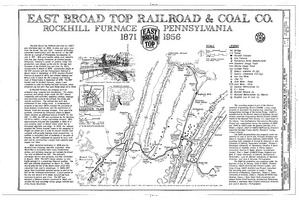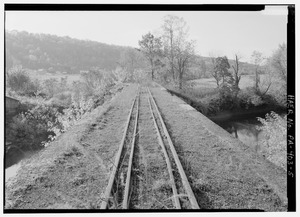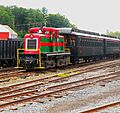East Broad Top Railroad and Coal Company facts for kids
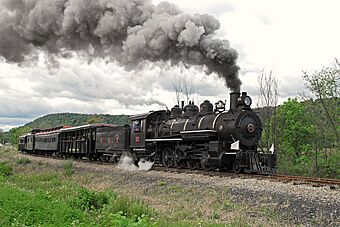
EBT No. 15 hauling an excursion train, 2006
|
|
| Overview | |
|---|---|
| Headquarters | Rockhill Furnace, Pennsylvania |
| Reporting mark | EBT |
| Locale | Huntingdon County, Pennsylvania |
| Dates of operation | 1872–1956 1960–2011 2020–present |
| Technical | |
| Track gauge | 3 ft (914 mm) |
| Length | 33 miles (53 km) |
|
East Broad Top Railroad
|
|
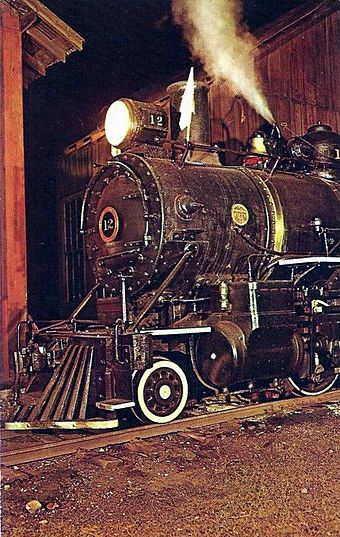
EBT Engine 12 after the railroad was re-opened in 1960.
|
|
| Nearest city | Rockhill Furnace, Pennsylvania |
|---|---|
| Area | 500 acres (200 ha) |
| NRHP reference No. | 66000666 |
| Significant dates | |
| Added to NRHP | October 15, 1966 |
| Designated NHLD | January 28, 1964 |
The East Broad Top Railroad (EBT) is a special historic railway located in Rockhill Furnace, Pennsylvania. It's known for its unique "narrow gauge" tracks, which are narrower than standard train tracks.
This railroad operated from 1871 to 1956. It is one of the oldest and best-kept narrow-gauge railroads in the United States. Because of its importance, it was named a National Historic Landmark in 1964. After closing for a while, it reopened as a fun place for tourists. It stopped running tourist trains in 2011. However, in February 2020, a new group bought the railroad. Regular train rides started again in the summer of 2021.
Contents
History of the East Broad Top Railroad
Why This Narrow-Gauge Railroad Is Special
The EBT is unique because it's a complete, original railroad. Most other tourist railroads are made up of parts from different places. All six of the narrow-gauge steam locomotives that pulled coal trains are still here. Some of these old engines are even used for the tourist trains today!
Other original equipment includes old track-gang cars. There's also the M-3 motorcar, which the EBT built using car parts. The M-1, a "doodlebug" motorcar, was built by the EBT in 1927. Most of the old freight cars are still on the property too. This includes flatcars, boxcars, and over 150 coal hoppers.
The railroad's original maintenance shops are also still here. They have old boilers, a 19th-century steam engine, and a system of belts and pulleys. This system powers old machines for metalwork, woodworking, and blacksmithing. About 33 miles (53 km) of the original track is still in place. About 5 miles (8.0 km) of it can be used for trains.
The EBT was named a National Historic Landmark in 1964. It was added to the National Register of Historic Places in 1966. In 1996, it was listed as one of America's Most Endangered Places.
Early Operations: 1872 to 1956
The East Broad Top Railroad and Coal Company started in 1856. Due to money problems and the American Civil War, it wasn't built right away. A new group of investors began building the railroad in 1867. They finished it as a 3 ft (914 mm) narrow-gauge line between 1872 and 1874.
Train service began in August 1873, from Mount Union, Pennsylvania to Orbisonia, Pennsylvania. By November 1874, it reached Robertsdale. The line later grew to over 60 miles of track. About 33 miles were main line.
The main job of the railroad was to carry coal from mines in the Broad Top Mountain area. At first, it took coal to Rockhill to be turned into coke for iron production. Later, it mostly carried coal to Mount Union. There, the coal was processed and moved to the Pennsylvania Railroad. The EBT also carried ganister rock (used for furnace lining), lumber, and passengers. It also moved farm goods, concrete, road tar, and other general freight.
As the iron industry slowed down in the early 1900s, coal became 90% of the railroad's income. Large factories making silica bricks opened in Mount Union. They became big customers for coal and ganister rock. The Mount Union yard had tracks for both narrow and standard gauge trains.
The EBT was usually profitable from the 1880s to the 1940s. This allowed it to update its equipment. The railroad's roundhouse, built in 1882, is one of the oldest still in use in the US. They also built a coal cleaning plant and full maintenance shops. Bridges were updated to steel and concrete. Wooden train cars were replaced with steel ones. Modern, powerful steam locomotives were bought from the Baldwin Locomotive Works. After World War II, most railroads switched to diesel engines. But the EBT kept its steam engines because they lasted a long time, and coal was cheap and plentiful.
In 1929, the EBT started a bus service called the East Broad Top Transit Company. They sold this bus service in 1941.
By November 1953, the railroad was featured in Trains magazine. But demand for coal was falling. Homes and factories were switching to cheaper oil and gas. The final blow came when the silica brick plants in Mount Union switched to oil and gas. Not enough coal was being sold to keep the mines and railroad going. The railroad stopped hauling coal on April 14, 1956. It was then sold to a company that scraps old metal.
First Tourist Operations: 1960 to 2011
Nick Kovalchick, the owner of the scrap company, decided not to scrap the railroad right away. In 1960, the towns of Orbisonia and Rockhill Furnace celebrated their 200th birthday. They asked Kovalchick to display a train. He did even better! He fixed four miles of track and two locomotives. He ran tourist train rides for several months that summer.
The rides were so popular that the railroad opened as a regular tourist attraction in 1961. The ride was extended to five miles (8.0 km). The railroad ran tourist trains every summer until 2011. From 1960 to 2008, the EBT operated the trains under Kovalchick Salvage. From 1956 until 2020, the Kovalchick family owned most of the railroad.

From May 2009 to December 2011, a non-profit group called the East Broad Top Railroad Preservation Association (EBTPA) leased the trains. This group wanted to buy the railroad and reopen all 33 miles (53 km) of its original main line. The EBTPA made many improvements and added special events. The lease ended in April 2012. The EBTPA and Kovalchick Salvage could not agree to continue, so the trains stopped running.
About the Tourist Rides
From 1960 to 2011, the railroad operated as a heritage railway. Trains were pulled by 3 ft narrow-gauge 2-8-2 steam locomotives. Older diesel engines were used as backup. Rides usually ran from May through October. Special holiday trains ran in November and December.
The rides were 10-mile (16 km) round trips and lasted about an hour. The EBT annual Fall Spectacular was a big event. All working equipment was used. It was held on Columbus Day weekend in October. The train would stop at Colgate Grove, a picnic area. The train was turned around on a special track called a "wye" for the return trip. The historic maintenance shops were often open for tours.
During this time, four of the six Mikado steam engines were used: #12, #14, #15, and #17. The heavier engines, #16 and #18, were never used. Engine #17 was used only sometimes.
There were plans to bring more of the East Broad Top back into service. But money and other issues prevented this. The usable track was never made longer.
Over the years, the working locomotives wore down. Rising costs and stricter safety rules led to many engines being retired. Engine #12 last ran in 2000, #17 in 2001, and #14 in 2005. Engine #15 was repaired and returned to service in 2005. It continued to run until the railroad closed in 2011.
Closure: 2012 to 2020
During the closure, a small team of paid staff and volunteers from the Friends of the East Broad Top (FEBT) kept the railroad facilities in good shape. They kept up with inspections for locomotive #15, hoping to reopen. No public rides happened from 2012 to 2019. However, diesel-powered trains ran for FEBT members on special days. Motorcar rides were also available for members.
The East Broad Top Preservation Association (EBTPA) bought some parts of the EBT. On June 3, 2013, they announced they had bought the first section. They bought the old spur track from the main line to the EBT yard. They also bought the EBT Mount Union yard. After these first purchases, the EBTPA could not afford to buy more sections.
The Friends of the East Broad Top continued many restoration projects in Rockhill Furnace. The owner, Joe Kovalchick, encouraged their work. FEBT also helped with regular maintenance and repairs.
Tours of the Historic Shops complex were offered for groups by appointment. Public tours were offered more often on certain summer days as the closure continued.
The nearby Rockhill Trolley Museum kept running its regular schedule and special events.
Sale and Reopening: 2020 to Present
On February 14, 2020, a big announcement was made in Rockhill. A new non-profit group, the EBT Foundation (EBTF), had bought the railroad. They planned to restart train rides in 2021. The sale included about 27 miles of track, the yard in Rockhill Furnace, and all the trains and equipment.
The EBTF board includes important people in railroad preservation. The sale did not include parts of the railroad that the EBTPA had already bought. The two groups are separate. It also did not include EBT standard gauge steam locomotive #3.
Right after the announcement, the EBTF started many projects to get ready. All six narrow-gauge steam locomotives were checked. Engines #14 and #16 were chosen to be restored first. Work began on them. Stall #8 of the Rockhill Roundhouse was fixed up to be a restoration area for the steam engines. A company was hired to fix the Rockhill Shops building. The FEBT volunteers are helping with the rest of the work. A fire safety system is being installed. Many track rebuilding projects happened around the Rockhill yard. Thousands of new ties were brought in to fix the tourist part of the line. In May and June 2020, there were some problems. An act of arson and a bridge damaged by a tall vehicle caused setbacks.
The East Broad Top reopened for limited operations in May 2021. It officially reopened for its first full season in May 2022. EBT No. 16 was back in operation in early February 2023.
Restoration Efforts
After the EBT opened as a tourist railroad, many buildings along the unused parts of the line fell apart. Some were lost to neglect or fires. Maintenance on the original shops and other buildings was ignored. Workers focused on running the trains and keeping the main areas working. This meant that many historic parts of the railroad were in danger.
In 1983, the non-profit Friends of the East Broad Top (FEBT) was formed. Their goal was to save and restore the East Broad Top. At first, the EBT and FEBT worked well together. But problems arose in 1985. The FEBT then focused on restoration in Robertsdale. They bought or leased two historic buildings there. They also worked on a leased EBT train car. In the late 1990s, their relationship improved. Since 2002, FEBT volunteers have been working on restoration in Rockhill Furnace. This work has grown a lot.
As of late 2022, the Foundation has three full-time paid track workers. On weekends, the volunteer FEBT Rockhill Restoration Crew works on the historic railroad. They restore buildings, machinery, and repair tracks and train cars. They also give tours and help maintain the property. Since 2002, more than half of the main maintenance shop complex has been restored. Several other buildings have also been fixed up. Five train cars are back in use, with three more being worked on. Six machines in the shops are working again. They are even making parts for other restoration projects. Seven sections of track have been repaired. The crew also works on projects outside Rockhill Furnace.
With the EBT Foundation buying the railroad, restoration work is moving much faster. The EBTF provides money and hires contractors for big jobs. The FEBT continues to handle smaller projects and help with larger ones. As of October 2020, the yard tracks at Robertsdale were cleared of brush. The scale track in front of the depot was restored. Three coal hopper cars were brought back to Robertsdale for display. This was the first time EBT train cars had been there since 1956.
In October 2021, the Friends group announced plans to rebuild the Saltillo station and water tank. The tank was burned by vandals in 1986. The station building was torn down in 2004 because it was in bad shape. In May 2025, the outside of a new station building was almost finished. It will look like the original Saltillo station but will meet modern building rules. In July 2025, one of the railroad's water columns was rebuilt and started working again in the Rockhill yard.
Track Rehabilitation
In December 2021, the railroad received a state grant for $1.1 million. These funds will be used to restore and reopen the main line to Saltillo. In May 2022, work began to clear growth and fix drainage along the track from Rockhill Furnace south to Saltillo.
Old buildings at the Colgate picnic grove were torn down. New picnic shelters, restrooms, and a boarding platform opened for the 2023 season.
During 2023-2024, the track was rebuilt and opened up to Pennsylvania Route 475. Tourist service began on this restored 1.3-mile section in October 2024. In June 2025, the Pogue Road crossing at Pennsylvania Route 994 was reopened. At Saltillo, clearing and grading of the track is moving north. Repairs to the Pogue Bridge will need heavy equipment. So, track restoration in 2025 will happen in sections that won't get in the way of bridge repairs or station building. Steam train service to Three Springs and Saltillo is expected by late 2025 or early 2026.
The line south of Saltillo is blocked by two tunnels built in 1874. They need major repairs. A special drone was used to survey their condition for planning.
At Robertsdale, which is separated from the main operating part of the railroad by the two tunnels, the first part of a paved walking path opened in October 2024. This path leads to the old coal mine sites. It will eventually be about one mile long and have signs explaining the history. Rail bikes and speeders now run over two miles of EBT track to Woodvale. In August, the Friends group began preparing the foundation for a replica of the old engine house.
Rockhill Trolley Museum
The Rockhill Trolley Museum is next to the railroad. It offers 3-mile (4.8 km) round-trip trolley rides during the tourist season. These rides are on the old Shade Gap Branch of the EBT. The track here has been changed to a wider gauge. The trolley museum is separate from the EBT, but they coordinate their schedules.
Friends of the East Broad Top Museum
The FEBT runs a museum in Robertsdale. It's called the Friends of the East Broad Top Museum. The museum is in the old EBT Robertsdale Station. It has historic items and documents. Robertsdale was a center for coal mining. The museum's goal is to share the history of the East Broad Top Railroad and the industries it served. The FEBT is also finishing the restoration of the Robertsdale Post Office building. This building will eventually hold the museum's exhibits. The station will be fully restored to how it looked in the past.
The Robertsdale Historic District and Woodvale Historic District were added to the National Register of Historic Places in 1992.
Locomotives
Steam locomotive No. 16, which had not run since 1956, was started up in July 2022. It ran during the 2023 season. But in April 2024, it was taken out of service because of a crack in one of its wheels. After 8 months of repairs and successful tests, No. 16 returned to service on August 30, 2024. No. 15 is the next locomotive chosen for restoration. No. 14 would follow after that.
To help with the EBT's growing operations, in February 2025, it bought a 1946 Porter diesel locomotive. This engine came from the Durango and Silverton Narrow Gauge Railroad. It is expected to be named No. 19.
In July 2022, the railroad received its first of four new passenger cars. They were built by a company in Bellingham, Washington. They look like 1890s passenger cars but have modern features. These include electric lights, heating, and modern restrooms. One car is a special baggage/combine car with wheelchair lifts.
The EBT once had two standard-gauge Baldwin 0-6-0 switching locomotives at the Mount Union yard. Switcher #6 was sold in 1975. In 2024, switcher #3, owned by the EBTPA, was sold and moved to a museum in Red Bay, Alabama.
See also
- Kinzua Viaduct, a structure that was also sold for scrap to the Kovalchik Corporation and is now a Pennsylvania State Park.
- List of heritage railroads in the United States
- List of National Historic Landmarks in Pennsylvania
Additional reading
- Joseph A Mannix (1960): A quick review of the East Broad Top, the narrow gauge of the East. Rockhill Furnace, Pa., East Broad Railroad and Coal Co.


